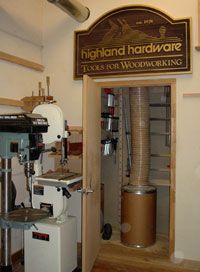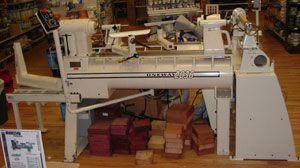


Okay, let's admit it our significant others silently accuse us of feeding our Freudian fixations in the workshop. "You already have one of those," they say, "do you really need a bigger one?" Look around some people's shops and you'll see the more-is-better syndrome at work: duplicate tools, massive motors, and racks of seldom used accessories. Hence the jokes about "he who dies with the most tools wins".
On the other hand, some of us struggle for years with the very cheapest stuff. My first table saw was a tiny 8-inch sheet-metal model advertised on the last page of Popular Mechanics in the 1970's for something like $24.95. It came with instructions for a cabinet which I built from a single 4 x 8 sheet of ¾" plywood. The little saw struggled to cut 2 x 4s. But it was all I could afford; it's still in the basement and it still runs. A couple of years ago I tried to give it to my son, who had no saw at all, and he brought it back with a scornful look on his face.
And I still have my first router, a ¼" Sears, Roebuck model that was on sale for about forty bucks. The low price hooked me. The router was wimpy, though, and using it was always discouraging.
When I started to take woodworking classes a few years ago I could finally afford some real tools. But like most of us, I wasn't in the sky's-the-limit range. So I started to look more carefully. When does size really matter? When is it worth paying more for quality? I don't want or need the best of everything often "good enough" works just fine. When does going first class make the most difference?
Here are more than a half dozen places where I've decided size matters and quality counts most. They include accessories, hand tools, and power tools. They range from a few dollars to a few thousand.
Start small. Really small, like a few microns. For a long time I used the paper dust masks sold everywhere and thought I was doing something for my lungs. Not much, it turns out. Those cheap filter-paper masks are called "nuisance masks". Good name - tying them behind your head is the first challenge. They seldom fit snugly and even if they do, the filter material doesn't catch much except big particles. Be safer spend a few dollars for some serious filtration. The National Institute for Occupational Safety and Health (NIOSH) rates filters made for particulates and airborne chemicals. An N95 filter , for example, filters 95% of airborne particles, while R95 and P95 ratings add oil-resistance as well.

NIOSH says clearly, however, that filters are a "last line of defense" behind ventilation and dust removal. You owe it to yourself to look at a real dust collector in addition to , not instead of , your face mask or respirator. In dust collection, size matters at both ends of the scale: more horsepower will collect more dirty air, and finer filters will catch the most dangerous dust. I started by adding a HEPA filter to my shop vacuum . Then I bought a dust collector. Now I'm looking at canister filters to boost its performance. A woodworking friend says that if he'd invested in dust collection sooner, he might not have gotten the cancer that laid him low last year. The lesson is, dust collection is one place where you can do some risk management right now.
Let's come back to hand tools in this case, pliers. Years ago I worked as a summertime electrician's helper to pay for college. If you've never used a journeyman's full-sized pair of lineman's pliers, you've been wasting a lot of energy. Whether you're adding an outlet in the shop, pulling a stubborn nail or stringing fence wire for a grape arbor, the heavier pliers (side-cutters, we call them) cut, twist, grab and pull so much better that you'll never use your cheap pliers again.
Moving on to benchtop power tools, spring for a really good cordless drill. Yes, you can go to the discount store and carry home three or four consumer grade drills for the price of one quality model. But the difference is dramatic. The high end drill has metal gears where the cheap model has plastic. The good drill has a better battery, because there's nothing as aggravating as having the battery die when you're not quite done with a job. Its chuck won't be a tad off center like the one on the last cheap drill I had. It'll grip the bit without slipping and the clutch adjustment will actually mean something. Considering how often you'll use it, this is one tool you really need.
When my first little router didn't cut it any more, I signed up for a class and learned what a real router can do. "Real" means one with soft-start, electronically variable speed and a ½" collet. A smooth plunge mechanism helps too. Now I have a couple of good routers. One of them lives in the router table most of the time. The big routers are easy to use, have enough power to speed through the job, and are flexible enough for a variety of tasks. I've used them to cut lap joints for wooden storm windows, turn out wooden train track for my grandsons, make box joints, cut mortise-and-tenon joints, and more. Some of my friends have multiple routers and more than one router table shop-made or purchased to make it easy to set up projects.
Turning to edge tools, my mini-lathe came with a starter set of chisels. Of course the first thing I did was rough out some spindles, which required the roughing gouge. Aargh ... the cheap roughing gouge was short, nasty and brutish. After a while I bit the bullet and bought a big, high quality roughing gouge, and it's the first tool I reach for almost every time. It's heavy enough to absorb vibration. It holds an edge so I'm not fighting the lathe. It's long enough for leverage. The added margin of safety it gives, by being less prone to catch, is worth the price.

Now we're coming to the big stuff. After enjoying the mini-lathe I had a chance to use a new, high-end woodturning lathe . My instant reaction was "Wow I've got to get one of these too." Modern big lathes combine power, weight and control. Variable speed is wonderful. The smoothness is amazing. The quality shows. You can drop some serious money here, so you may want to visit other people's shops or enroll for a turning class where you can experience these machines first hand. But the experience may draw you in, as it did me.
Which leads to my latest "size matters" purchase, a bigger bandsaw. Recently it's become possible to buy more bandsaw than the "standard" 14-inch model for a price that won't break the bank. What you get is power, weight and new possibilities. My larger saw speeds through work that the small one did grudgingly. After a little effort with chainsaw and splitting wedges, I can resaw a log and make my own stock. Almost immediately a friend called to say he was removing a walnut tree in his yard, and did I want the best parts? You bet. Now I have my eye on a big old cherry tree that fell during a storm, just one yard away from mine.
They say Sigmund Freud quipped that "Sometimes a cigar is just a cigar." When you're finally ready for it, a bigger or better tool is just the thing for the job.